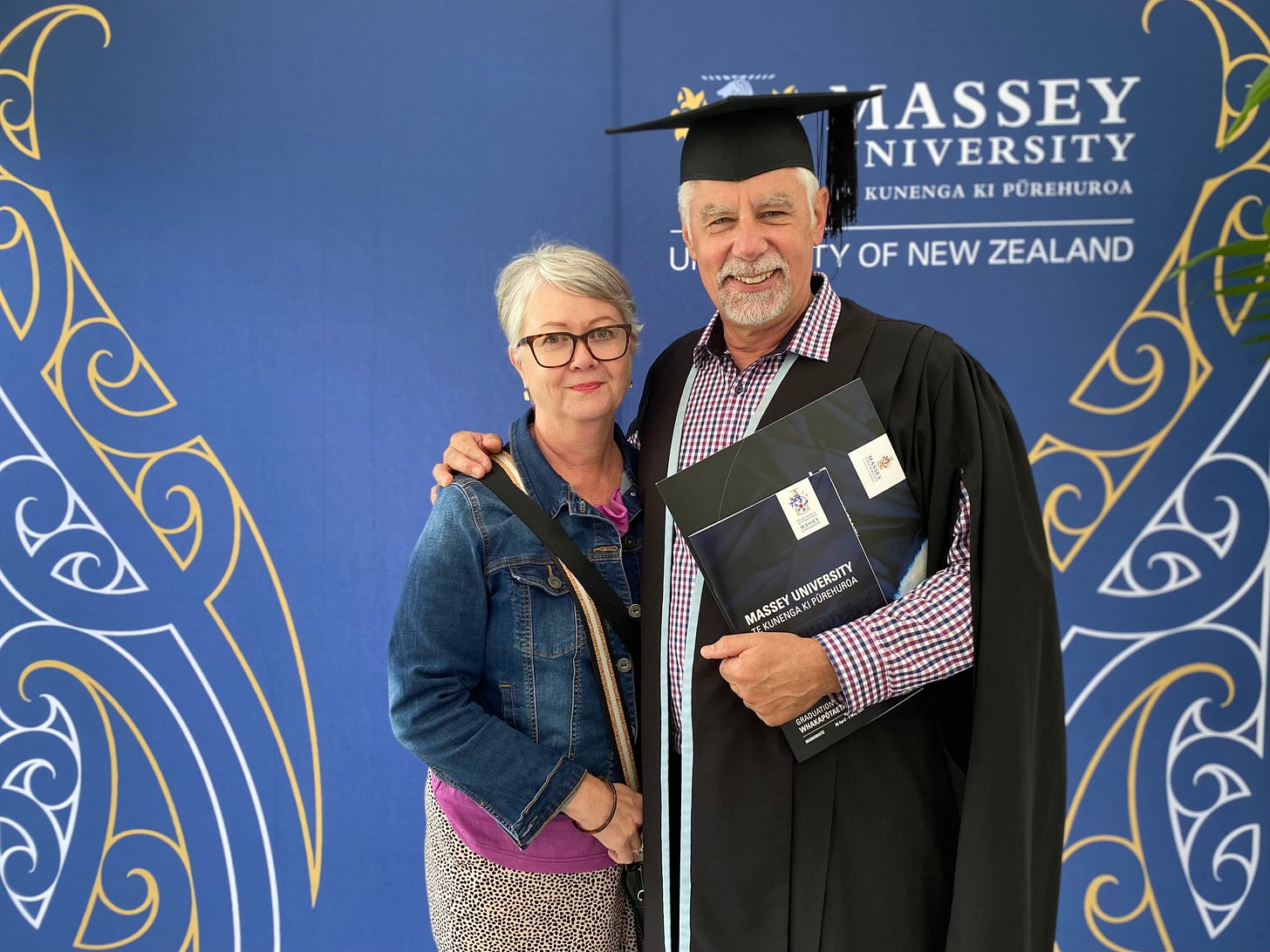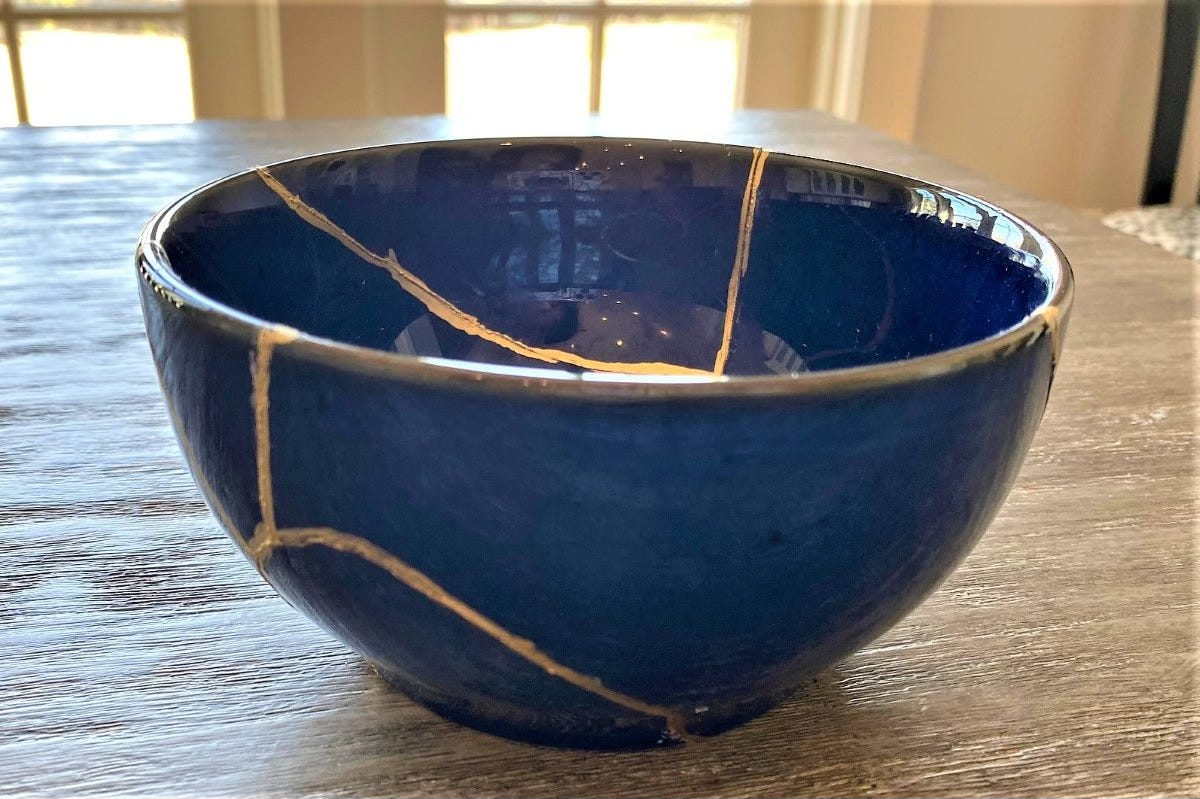When Your Brokenness Becomes Gold
Graduating at 63, road trips in Autumn, and the ancient art of Kintsugi
Last week was a milestone in my life.
I graduated from University at age 63 with a Graduate Diploma in Psychology. My wife and I trundled off to Palmerston North to attend the ceremony and be awarded the qualification.
However, while we enjoyed the trip - New Zealand in Autumn is just stunningly beautiful - and the pageantry of the awards ceremony, it was something else that caught my imagination.
I heard about a fascinating Japanese practice that treats brokenness and mistakes as treasure. And it occurred to me that this was a wonderful philosophy to have in one's life.
One of the people speaking at the University ceremony mentioned the ancient Japanese art of Kintsugi, something I hadn't heard of before.
Kintsugi1, also known as Kintsukuroi, is both a philosophy and an artistic endeavour.
As a philosophy, it promotes the idea that breakages and brokenness in objects aren't something to be thrown out or even disguised. Instead, they're part of the life and history of an object, something that's a normal outcome of time and use.
The art is to repair the cracks and mend the broken pieces not with superglue but with urushi lacquer that is dusted with or has mixed into it some fine powdered gold, silver or platinum.
I find that a wonderful, fascinating idea.
The object now has its wear and tear recorded as part of its ongoing existence and it's done in a way that doesn't try to hide the imperfections but seeks to highlight them. With gold, no less! The 'mistakes' and ravages of time are embraced as features that actually make the object unique and, therefore, even more treasured than before.
As master restorer, Hiroki Kiyokawa from Kyoto says, "The fractured part where Kintsugi is applied becomes a new landscape in itself." Watch him explain further in this short video from BBC Global.
That’s a Very Powerful Idea. Let me state that again:
"...the fractured part becomes a new landscape in itself."
Wow. Think about that for a while.
To many people, Kintsugi is a powerful metaphor for life.
For a start, we usually grow up aiming in life, or at least hoping, for wholeness and perfection even if we don't admit it. It's probably an underlying, subconscious goal or expectation. We hope to have perfect families, perfect careers, perfect health, perfect marriages and perfect financial situations.
You know, like the ones that are advertised to us ad nauseam, day in and day out.
Then, when things happen - cos things will ALWAYS happen - we feel let down, angry, hurt or very disappointed. Sometimes, it seems like parts of us crack.
It might be a job where, despite your 110% efforts and commitment over many years, you're one day unceremoniously made redundant.
It could be a marriage that, despite you wanting it to be a loving and long-term fulfilling experience for both of you, simply breaks one day.
Maybe a business fails, possibly because your partner ripped you off.
Perhaps a friend unfairly dumps you.
You get bloody cancer.
Or, something you once absolutely believed in becomes alien to you and the silence you experience from others is like a huge punch to the gut.
While these experiences may seem to kill off part of us that was once alive with hope and expectation, at the very least they scar us.
Pain notwithstanding (that too is very normal) we have two main options for how to proceed.
Firstly, after a period of grieving, we can hang on to the unfairness of it all. We revisit the 'what-ifs.' We hold on to the residual anger. We live, talk and walk around like freshly wounded people. Somehow, we have let the brokenness define us as less than.
Or, secondly, after grieving, we can embrace the cracks and breaks as something that is a very normal part of being alive. See them as the shadow side of being able to move, love, serve and create.
We cannot say that we are open to the possibilities of what life brings unless we are willing to take whatever comes. Even those things that are unexpected, unfair and costly.
But here's the good news.
Like Kintsugi, if we can treat our cracks and breakages as something not to be resisted and regretted, but something to be accepted and learned from, then we can turn them into gold.
That gold becomes not only a part of our life from then on, but a feature of our life. If we wish it to, it can:
inform how we approach life more realistically
help us grow more wise, for wisdom grows from embraced experience
enable us to offer commonality and support to others when they too are battered, bruised and broken.
Now, that's truly valuable, don’t you think?
FINALLY
Let me know if this was interesting and useful to you. It helps me feel like there are actual readers out there! Otherwise, I just wouldn’t really know. :)
AND
I have to ask: Have you subscribed for free? Come on, you know you want to.
https://en.wikipedia.org/wiki/Kintsugi






